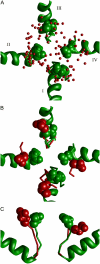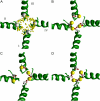Sodium channels: ionic model of slow inactivation and state-dependent drug binding
- PMID: 17496040
- PMCID: PMC1948041
- DOI: 10.1529/biophysj.106.100248
Sodium channels: ionic model of slow inactivation and state-dependent drug binding
Abstract
Inactivation is a fundamental property of voltage-gated ion channels. Fast inactivation of Na(+) channels involves channel block by the III-IV cytoplasmic interdomain linker. The mechanisms of nonfast types of inactivation (intermediate, slow, and ultraslow) are unclear, although the ionic environment and P-loops rearrangement appear to be involved. In this study, we employed a TTX-based P-loop domain model of a sodium channel and the MCM method to investigate a possible role of P-loop rearrangement in the nonfast inactivation. Our modeling predicts that Na(+) ions can bind between neighboring domains in the outer-carboxylates ring EEDD, forming an ordered structure with interdomain contacts that stabilize the conducting conformation of the outer pore. In this model, the permeant ions can transit between the EEDD ring and the selectivity filter ring DEKA, retaining contacts with at least two carboxylates. In the absence of Na(+), the electrostatic repulsion between the EEDD carboxylates disrupts the permeable configuration. In this Na(+)-deficient model, the region between the EEDD and DEKA rings is inaccessible for Na(+) but is accessible for TMA. Taken together, these results suggest that Na(+)-saturated models are consistent with experimental characteristics of the open channels, whereas Na(+)-deficient models are consistent with experimentally defined properties of the slow-inactivated channels. Our calculations further predict that binding of LAs to the inner pore would depend on whether Na(+) occupies the DEKA ring. In the absence of Na(+) in the DEKA ring, the cationic group of lidocaine occurs in the focus of the pore helices' macrodipoles and would prevent occupation of the ring by Na(+). Loading the DEKA ring with Na(+) results in the electrostatic repulsion with lidocaine. Thus, there are antagonistic relations between a cationic ligand bound in the inner pore and Na(+) in the DEKA ring.
Figures









Similar articles
-
Molecular pore structure of voltage-gated sodium and calcium channels.Braz J Med Biol Res. 1994 Dec;27(12):2781-802. Braz J Med Biol Res. 1994. PMID: 7550000 Review.
-
Modeling P-loops domain of sodium channel: homology with potassium channels and interaction with ligands.Biophys J. 2005 Jan;88(1):184-97. doi: 10.1529/biophysj.104.048173. Epub 2004 Oct 8. Biophys J. 2005. PMID: 15475578 Free PMC article.
-
Atomic determinants of state-dependent block of sodium channels by charged local anesthetics and benzocaine.FEBS Lett. 2006 Nov 13;580(26):6027-32. doi: 10.1016/j.febslet.2006.10.035. Epub 2006 Oct 24. FEBS Lett. 2006. PMID: 17070808
-
Selective ion permeation involves complexation with carboxylates and lysine in a model human sodium channel.PLoS Comput Biol. 2018 Sep 12;14(9):e1006398. doi: 10.1371/journal.pcbi.1006398. eCollection 2018 Sep. PLoS Comput Biol. 2018. PMID: 30208027 Free PMC article.
-
Molecular properties of brain sodium channels: an important target for anticonvulsant drugs.Adv Neurol. 1999;79:441-56. Adv Neurol. 1999. PMID: 10514834 Review.
Cited by
-
Structural model for dihydropyridine binding to L-type calcium channels.J Biol Chem. 2009 Jul 10;284(28):19006-17. doi: 10.1074/jbc.M109.011296. Epub 2009 May 5. J Biol Chem. 2009. PMID: 19416978 Free PMC article.
-
Potassium channel block by a tripartite complex of two cationophilic ligands and a potassium ion.Mol Pharmacol. 2010 Oct;78(4):588-99. doi: 10.1124/mol.110.064014. Epub 2010 Jul 2. Mol Pharmacol. 2010. PMID: 20601455 Free PMC article.
-
Mutations in the transmembrane helix S6 of domain IV confer cockroach sodium channel resistance to sodium channel blocker insecticides and local anesthetics.Insect Biochem Mol Biol. 2015 Nov;66:88-95. doi: 10.1016/j.ibmb.2015.09.011. Epub 2015 Sep 25. Insect Biochem Mol Biol. 2015. PMID: 26407935 Free PMC article.
-
The Receptor Site and Mechanism of Action of Sodium Channel Blocker Insecticides.J Biol Chem. 2016 Sep 16;291(38):20113-24. doi: 10.1074/jbc.M116.742056. Epub 2016 Aug 3. J Biol Chem. 2016. PMID: 27489108 Free PMC article.
-
Structural modeling of calcium binding in the selectivity filter of the L-type calcium channel.Eur Biophys J. 2010 Apr;39(5):839-53. doi: 10.1007/s00249-009-0574-2. Epub 2010 Jan 7. Eur Biophys J. 2010. PMID: 20054687
References
-
- Ulbricht, W. 2005. Sodium channel inactivation: molecular determinants and modulation. Physiol. Rev. 85:1271–1301. - PubMed
-
- Hoshi, T., W. N. Zagotta, and R. W. Aldrich. 1990. Biophysical and molecular mechanisms of Shaker potassium channel inactivation. Science. 250:506–507. - PubMed
-
- Vassilev, P. M., T. Scheuer, and W. A. Catterall. 1988. Identification of an intracellular peptide segment involved in sodium channel inactivation. Science. 241:1658–1661. - PubMed
Publication types
MeSH terms
Substances
LinkOut - more resources
Full Text Sources

